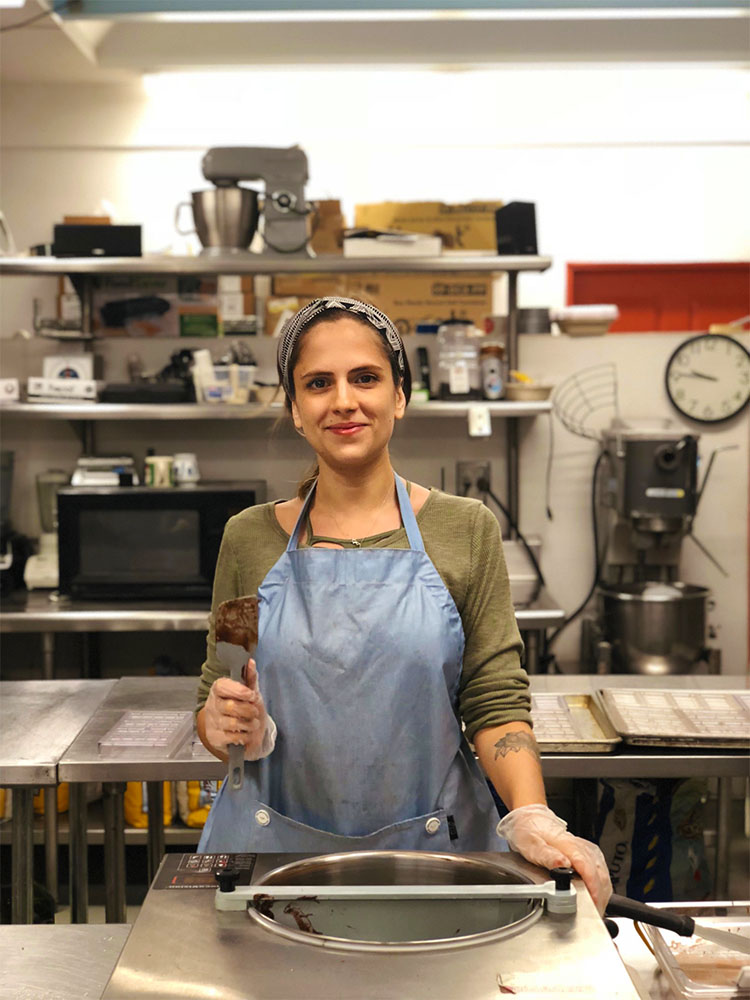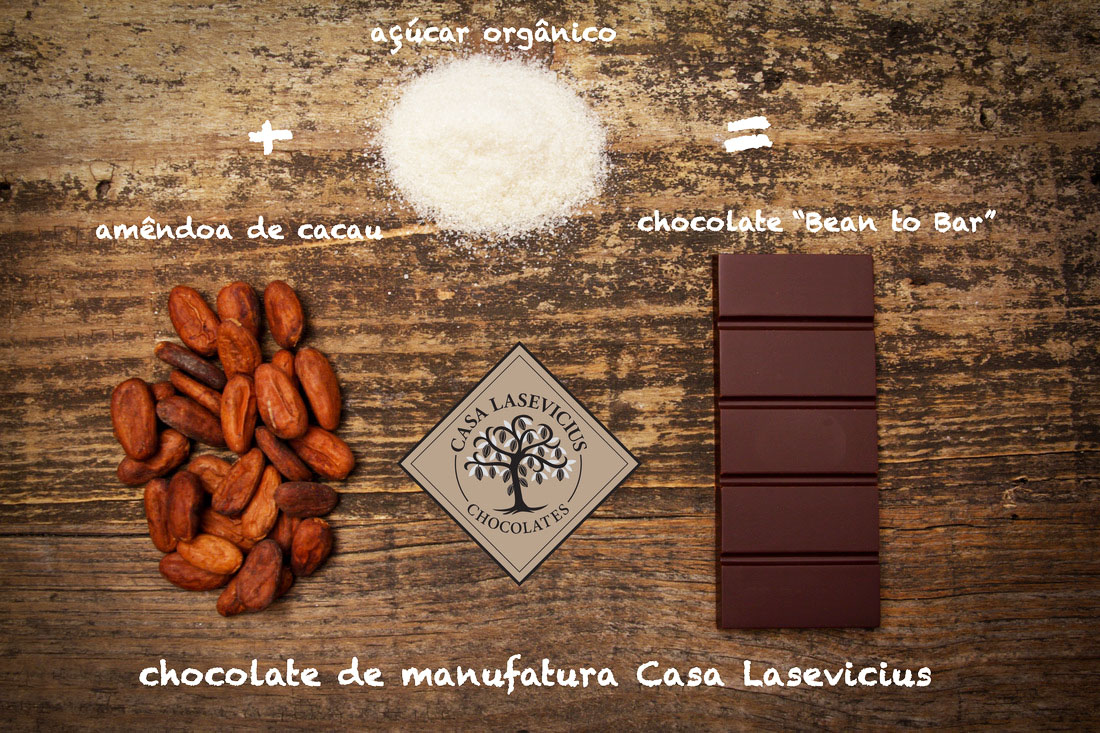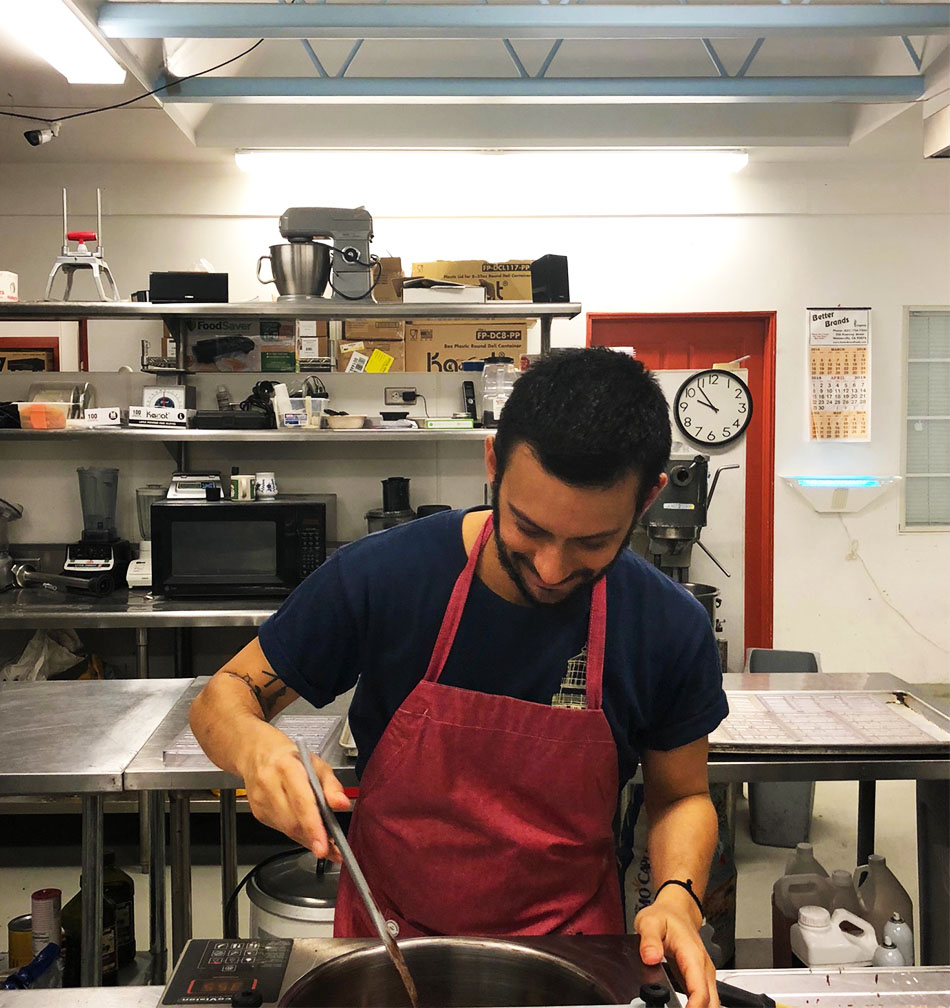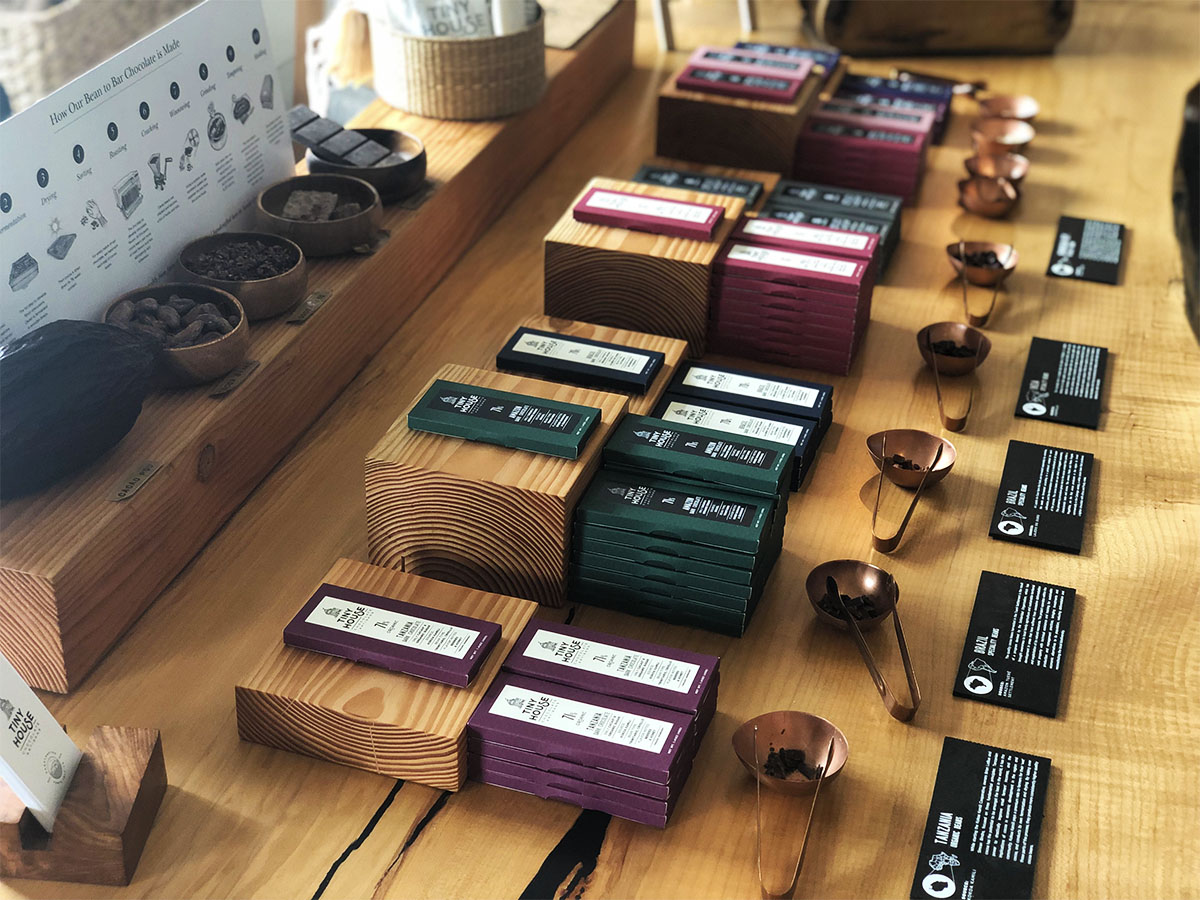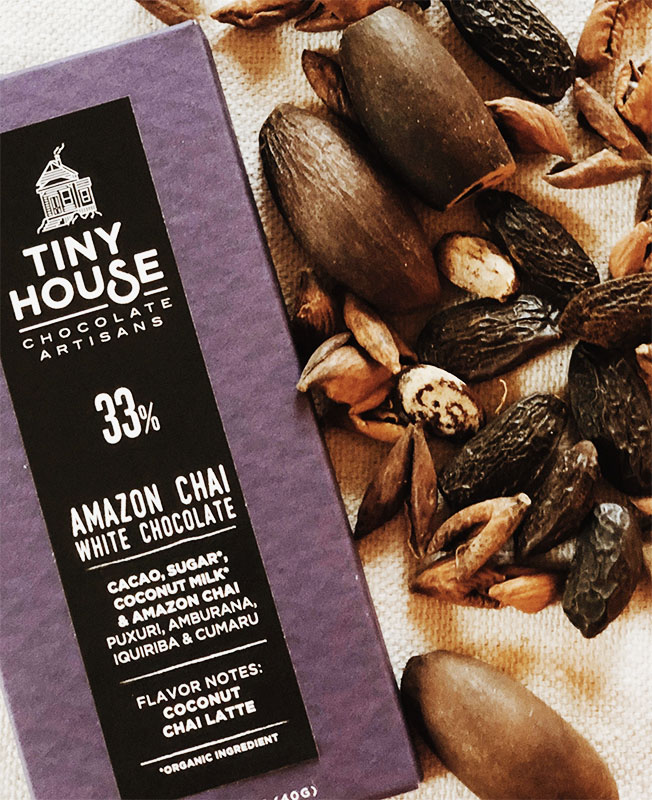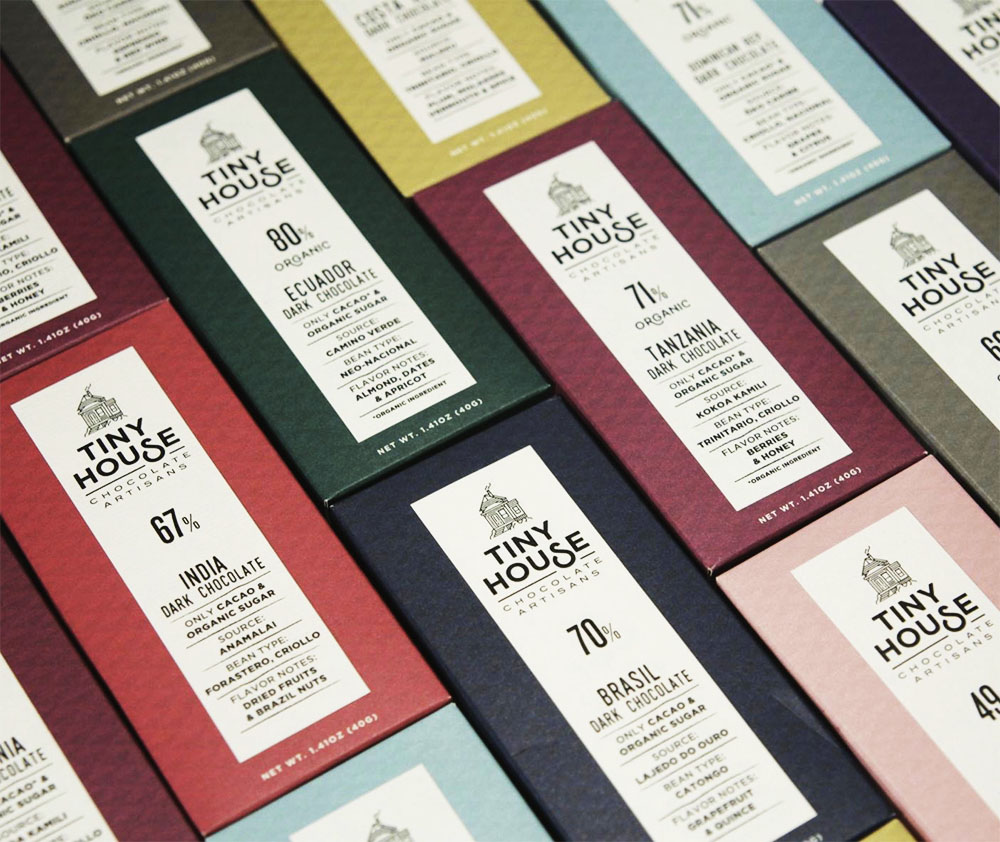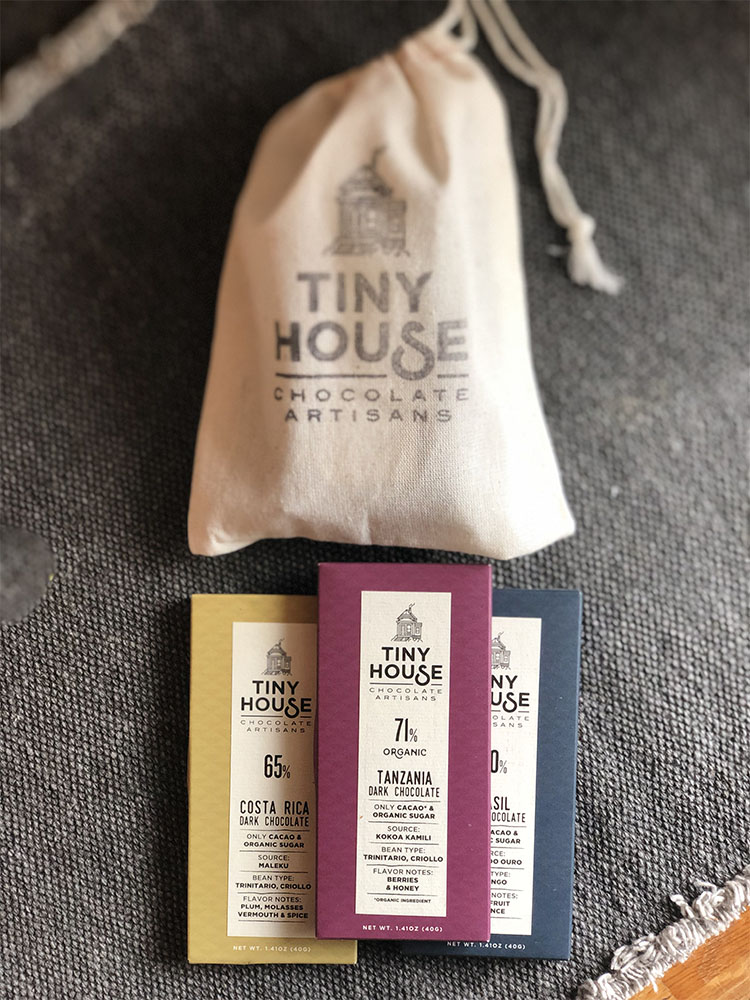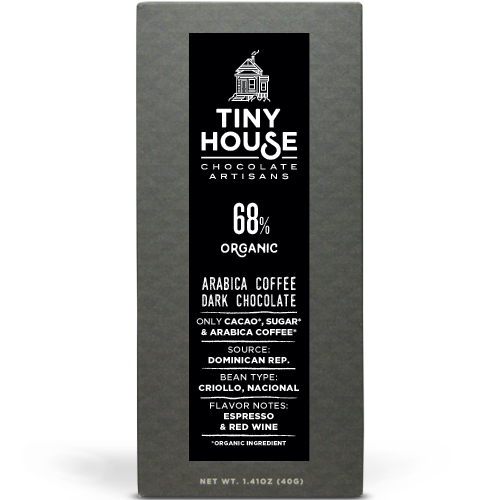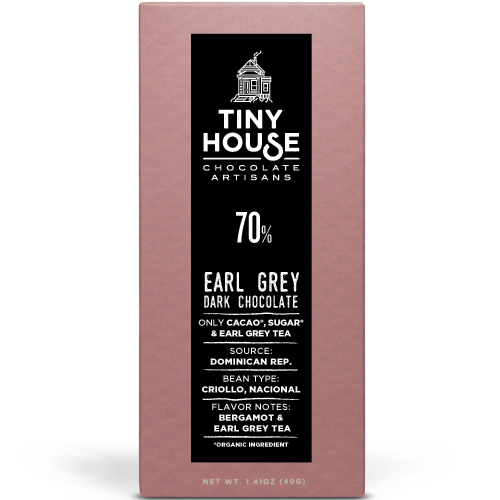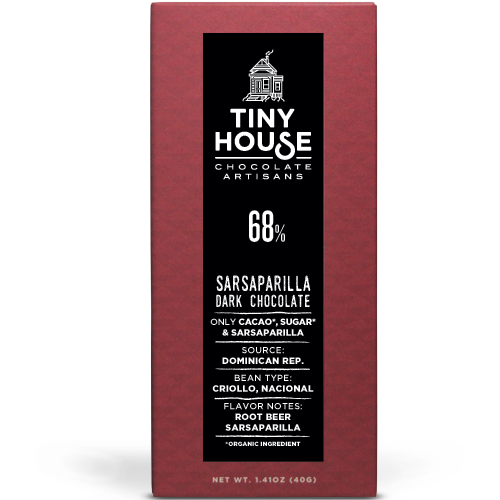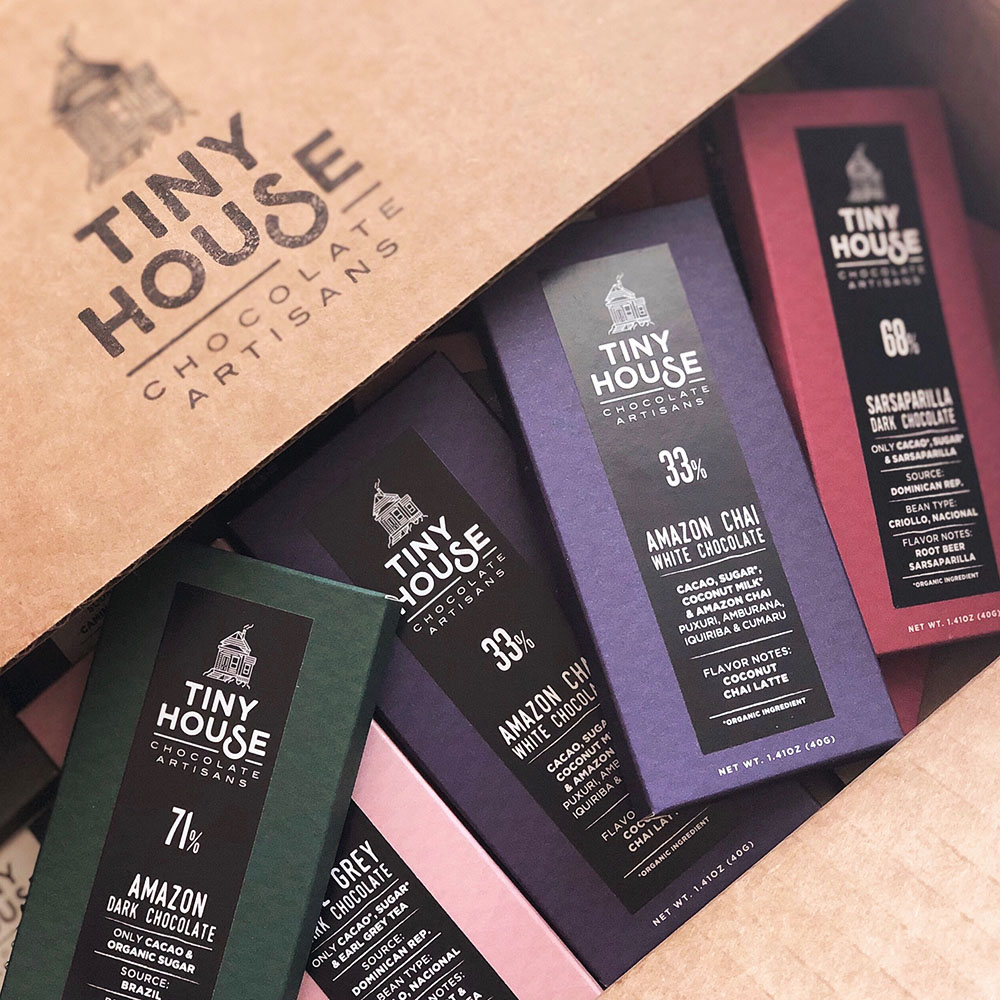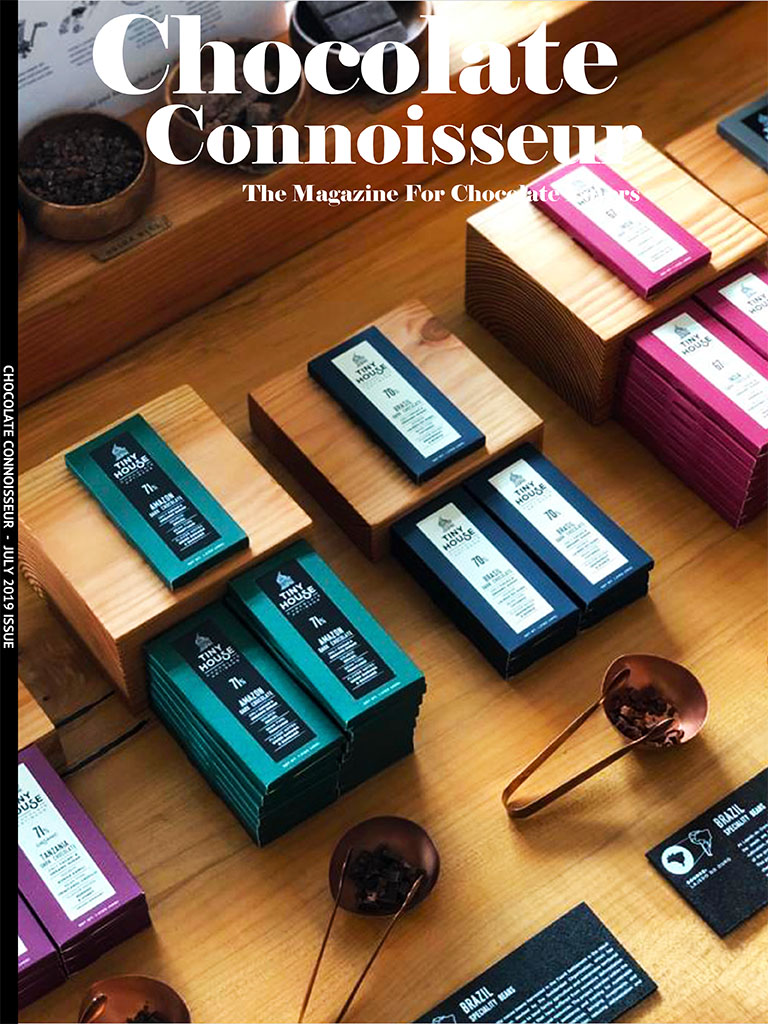In Focus: Tiny House Chocolate
by Eric Battersby
Tiny House Chocolate – three words you likely never expected to read together, and yet this word trio will most certainly bring a smile to your face once you’ve uncovered its chocolate treasures.
Meet Maiana Lasevicius and her husband/business partner, Gustavo Hilsdorf, co-founders of Tiny House Chocolate in Santa Cruz, California. Five years ago, the new chocolate couple were still in Brazil, where Maiana had lived her whole life, and where Gustavo, although born in the USA, grew up as well.
Back then, they worked in advertising, living a very, very busy life. As Maiana notes –
“Advertising agencies are insane in Brazil. I think we have always liked working with design, branding, planning, etc., but it was somewhat frustrating. We used to work a lot, but that hard work didn’t always pay off, because the client could change the whole idea, cut the budget… and then all the hard work for months, the sleepless nights, would all be for nothing.”
Feeling entrenched in the advertising rat race, the couple felt a growing desire to create something of their own… something unbridled and free of the corporate constraints… coupled with a change of scenery to boot. Finally, in 2015, they decided to move to the US, seeking a new life and a new pace, after working in São Paulo’s hectic advertising world for then over a decade.
Before taking the plunge, however, Gustavo and Maiana visited Santa Cruz on vacation, “with a new chapter of our lives yearning to be lived,” as Maiana notes. She then elaborates further –
“We let the curiosity, the dream to have our own business, and our most profound desire to create and explore, lead our way into the chocolate world. Gustavo already lived here for a while in 2010, but it was my first time in the USA. We were exploring, rehearsing our arrival, getting acquainted with our potential new city.
I remember gazing out at the beautiful sunsets in California in amazement, and at the same time feeling upset about never even catching the sunsets in Brazil, because we always worked so late.
I looked at the sky and started to dream about the life I would love to live here. From that moment on, we set the goal to watch as many sunsets as possible, and we let our intuition, with a deep feeling that life could be better, guide our way.”
As Maiana and Gustavo left Brazil to start their new adventure together, they contemplated several different business ideas: ceramics, jewelry, opening a gift store, working with glass, and even creating their own branding agency.
A deep connection to chocolate, however, would soon alter the couple’s fate.
All in the Chocolate Family
In the grand mosaic of chocolate makers around the world, one thing, surprisingly, fails to connect them all together – an early love for chocolate.
Although we certainly, on occasion, encounter chocolate makers with a lifelong love for chocolate, more often than not, great chocolate only entered their lives relatively recently (which of course makes sense, since the movement itself still has much room to grow).
For Maiana Lasevicius, however, chocolate entered her world at quite a young age —
“The inspiration of working with chocolate started early in my childhood, as tempering and using chocolate to cook has been in my family for generations.
My first memory of chocolate is related to my grandmother (on my father’s side). She used to make beautiful Easter chocolate eggs for the whole family (in Brazil, chocolate eggs are very popular, and big, sometimes up to two pounds).
I also remember my Aunt Claudia making delicious Brigadeiros (one of the most traditional Brazilian sweets). She would generously bring those to any family reunion, and actually sold them as an extra source of income as well.”
It’s no shock that her father, Bruno, played a pivotal role in the new adventure Maiana and Gustavo embarked on in the USA. As Maiana fondly puts it, “He was the spark that started the flame in our hearts.”
Casa Lasevicius Paves the Way
Near the same time Gustavo and Maiana started their inter-country move, Bruno also ventured into new territory — actually testing the first batch of bean-to-bar chocolate for his very own company. Along with a few other chocolate makers, Bruno joined the first generation of bean-to-bar chocolate makers in Brazil, where the movement started circa 2015.
Bruno’s company, Casa Lasevicius (http://www.casalasevicius.com.br), actually started in 2012, when an early twentysomething Maiana went off traveling in Argentina. She brought home some Argentinian Dulce de Leche and Alfajores (an Argentinian specialty that you’ll feel guilty eating but will love nonetheless). Maiana elaborates —
“My father has always been an amazing cook, and a month later he came up with his own Alfajor recipe (the best one I have ever had!).
After a while, he started making different kinds of sweet pastries like pannetone, belgian chocolate bars, chocolate cake, brigadeiro, alfajor, pão de mel (another Brazilian pastry), truffles, bonbons, and easter eggs, and I helped him selling those delicious treats at my work to my colleagues.”
The following year, Maiana met Gustavo, and not long after they not only planned the USA move, but also decided to partner with Bruno (as well as her Aunt Claudia, also part of Casa Lasevicius), to begin their own bean-to-bar chocolate adventure.
“I like to think that, in a way, I was part of the beginning of his chocolate business, and he was definitely an essential part of ours. And besides, all the help and incentive he gave us, he was the first one to believe we could do it.”
And So It Begins…
Maiana felt privileged to enjoy both the rising movement in Brazil in its first stages, and the established market growing at a fast pace in the US. “Starting to make bean to bar chocolate was only a matter of time for us,” she says.
Here the advertising background served the couple well. From the very beginning, they embraced the challenge of developing the brand on their own. “Tiny House Chocolate became a way to express our creativity,” Maiana adds.
With so much experience in their “previous lives” (plus they both graduated in communications, with an emphasis on advertising and branding), they felt significantly more prepared for some of the early challenges than other fledgling entrepreneurs might be.
Gustavo worked as a Designer and Art Director for many years, while Maiana worked as a Strategic Planner.
“All the knowledge we have in those areas definitely guided us — without paying lots of money for a good logo, a nice website, etc. Gustavo is the brilliant mind (and the hands) behind our brand identity and every communication material we’ve created so far.”
After 2 years designing the brand, the website, packaging, testing recipes, and finding the best cocoa beans for their tastes, the aspiring chocolate couple finally felt confident enough to start selling Tiny House Chocolate.
“Opening a business in a different country, being away from home, from our family, made us see life in a different way. It made us connect to Santa Cruz in a distinct way as well. It was important for us, in order to make new connections, new friends, and to feel at home.
We believe making chocolate was the best ‘excuse’ and opportunity to integrate, to be a part of and yet also serve our new community. We found out chocolate is the best way to one’s heart!”
The Tiny House Movement Inspires Tiny House Chocolate
“Nourishing the simple life.” The minimalist concept of the Tiny House Movement inspired Gustavo and Maiana to create not only their company name, but also its values. Maiana explains —
“When we left home, the tiny house movement was the translation of what we wanted to ‘achieve’ when we moved to Santa Cruz. We wanted a simpler and better life… we wanted to be closer to nature… to buy less, waste less, and live our full potential as human beings.”
The couple still wants to further develop the tiny house movement/concept within their brand. Maiana feels there’s still much to be explored, but for now it’s more of a mindset, reminding them both to embrace the virtue of simplicity in different aspects of their chocolate, and their lives outside of it as well.
“Fewer walls, more horizons.”
Learning the Trade
Gustavo and Maiana learned how to make chocolate from her father Bruno, “Of course!” she says. When they decided to start the business, he flew to California and spent an entire week teaching his daughter and son-in-law everything he knew at the time.
In addition to her father’s lessons, Maiana believes many of the new chocolate makers emerging in recent years were strongly influenced by John Nancy of Chocolate Alchemy —
“He is the Internet Chocolate Guru, so we watched his videos and forum posts, and I remember buying our first cocoa beans from his website – single origin from Nicaragua, Ecuador, Madagascar, and Peru.
We bought the most basic machinery we needed to start, like the Behmor coffee roaster, a 2L melangeur, a manual coffee grinder, chocolate molds from Brazil (which we still use by the way), and that’s it. That’s how we started our company.”
Grandpa Ends Any Chocolate Doubts
Last year, Gustavo and Maiana were both still working two jobs in Santa Cruz. She worked in a Brazilian restaurant (a little homesick perhaps?), and Gustavo still works in a print shop.
“We were tempering chocolate until midnight, with a lot of doubts in having our own business and making chocolate as our main source of income.”
As the Tiny House Chocolate future hung in the balance, some deep inspiration from back home, thanks to Maiana’s grandfather, Manoel, helped steel the couple’s chocolate resolve.
Many years ago now, Manoel met his wife-to-be, Maria Alice, in Portugal, and the couple decided to start a new life in another country… sound familiar? They moved to São Paulo, Brazil, where Manoel learned a new artisan skill, opening a tailor shop. Then in the following years, they also owned a furniture store, bought land, and built both commercial and residential properties.
Maiana reflects, “He was a good business/salesman, and I think somehow I inherited his sales abilities. I’ve been told I’m a good seller.”
Unfortunately, her grandfather fell ill back in Brazil, and some months before he passed away, he couldn’t eat anymore. Maiana reflects –
“I remember waking up, still tired from a long night working, and my mom had sent me a picture and a video of him, eating a tiny little piece of our chocolate… and enjoying it so much.
From that moment on, the pleasure I felt in my heart, of being able to give something special to my family and my community was bigger than anything else. After that, I never felt any doubt about being a chocolate maker. It gave us the strength to believe in our work and keep going.”
During the struggle, that deep connection to an ailing loved one back home helped put Maiana and Gustavo over the top. Tiny House Chocolate never looked back, and Maiana will always hold that wonderful memory of her grandfather close in her heart.
She also enjoys feeding that feeling she received from her grandfather on the one fateful night, when she now connects with Tiny House customers –
“That feeling is always strengthened when we participate in events and have the opportunity to witness our customers reaction to eating our chocolate. Gustavo and I both love attending events, so we’re able to truly meet and chat with our customers.”
Ethics and Origin
It’s almost time to dive into the chocolate (and I so can’t wait, with these four bars just sitting right here staring at me), but before we do, let’s take a look at the cacao behind the bars. Two of the core sources of Tiny House’s cacao are Lajedo do Ouro and the Tuerê Settlement, both in Brazil.
Tiny House, big closeup, nibs included
Lajedo do Ouro
At the Lajedo do Ouro farm, the fruits are harvested separately by varieties, the seeds are fermented according to a protocol created for each cultivation, and the cocoa beans are sun-dried and bagged separately.
Maiana offers a little more insight on Lajedo do Ouro’s work —
“Their pioneering procedure gives rise to cocoa varietals with specific tastes and aromas.
The owners, Pedro and Maria Ângela Magalhães, are the first cocoa producers in the region to invest commercially in the Catongo variety, a white (albino) cacao bean that produces a lighter chocolate.
The chocolate we make with those albino beans tastes like a dark milk chocolate (without milk, off course!), bold in taste but very smooth and light in the color. We are one of the very few makers that are using their Catongo beans.”
Unfortunately, of the four bars I’ll soon be tasting, none of them feature Catongo beans… but I may just foresee a Catongo cacao bar in an upcoming Chocolate Connoisseur chocolate offer, so stay tuned…
Zezinho inspects a cacao pod at the Tuerê Settlement
Tuerê Settlement
The quality cocoa beans harvested in the Tuerê Settlement are the result of a program devised by the Solidaridad Organization, which brings attention to local family agriculture and sustainable territorial development in areas that have suffered from excessive deforestation and exploitation of natural resources.
The project offers technical assistance and training for sustainable production and management practices. It also brings both investment and economic alternatives to the local population, hoping to reduce deforestation and to reconstitute local biodiversity.
It’s a challenging task, particularly with the most recent and alarming election in Brazil that saw a dangerous candidate, Bolsonaro, win office. He’s already rolling back what little regulation existed on Brazil’s rainforests, so the important work done at the Tuerê Settlement now grows even more important.
Maiana elaborates —
“We buy our beans from Jose Silva Rosa (a.k.a. Zezinho), owner of Três Irmãos Farm, and one of the producers of the Tuerê Settlement. Our other contact, Pedro Souza, is the Technician of Solidaridad. He offers technical and agricultural support to the producers and connects the growers with cacao buyers.
My father has a great relationship with them. Early this year the Tuerê Settlement invited him to do a workshop for all the producers, on chocolate making, quality, and chocolate tasting.
There are several cacao producers in the region of the Tuerê Settlement offering different cacao beans with excellent quality, so much so that we can even consider it a terroir — Terroir Tuerê.
The sensory characteristics of all those cocoa beans are influenced by the soil type, microclimate, and geography of the Tuerê region, which creates a very unique identity for the beans it produces… like a signature, expressed in the quality of the flavors and aromas…
We are passionate about the beautiful project behind these cocoa beans. The training and knowledge they share with the farmers has improved the quality of their beans significantly, and we couldn’t be more grateful for working with the farmers who take care of our beloved Amazon.”
Gustavo and Maiana actively seek specialty cocoa beans sourced from farms and fermentaries all over the world. As Maiana notes –
“Each culture, each land, has its own characteristics and methods, and that goes into the cultivated cocoa. We believe one of the best ways to get to know a different/new culture is by their food, and why not by their cocoa and chocolate too?”
She says that, for their 2019/2020 collection, Tiny House will offer a special variety of beans from Brazil (Amazon, Bahia, Espírito Santo and Pará), and also beans from Dominican Republic, Tanzania, and India. They also plan to utilize special micro batches of beans from Guatemala, Bolivia and Fiji.
Ethical Sourcing holds much weight for Tiny House Chocolate as a business practice, and sourcing beans from socially-responsible farms and fermentaries stands tall as a top priority. Maiana and Gustavo feel it’s important for everyone in the cacao supply chain to be both seen and respected. They also feel that it’s vital for everyone to work in a sustainable environment, while being paid properly as well.
“As an artisan bean to bar chocolate maker, we don’t want to profit at any cost… we don’t want to sell the cheapest chocolate.
Bean to bar chocolate might cost 40%, 50% more because we buy specialty and organic beans, but there’s definitely a market for it. People are starting to realize that a premium quality chocolate, crafted with socially-responsible beans, is more expensive, and our customers are happy to pay more for it.”
Wisely, in what can only be seen as a win-win situation for all parties involved, Tiny House often partners with Casa Lasevicius to source cacao, so they can order more appropriate, larger quantities, share the beans, and build even better relationships with the local farmers.
Let’s Make Chocolate
Although Maiana and Gustavo certainly research and experiment frequently, at the end of the day, their style, their own way of making chocolate, simply stems from their collective intuition.
Maiana explains further –
“Intuition is the word that better describes the way we make chocolate. Listening to our hearts and allowing ourselves to be creative, while following our endless curiosity, all with a strong will to make our chocolate delicious each and every time.
It’s amazing how different chocolate makers make different chocolate bars using identical beans, from the same origin, same source, and basically going through the same process.
Every new origin or new flavor we launch is a journey for us as makers, and for our customers.
We love that it’s something we created from scratch. There is so much of us in every bit of our company.
We love that we’re free to create, recreate, experiment.
We love the idea of transformation… being able to transform cocoa beans into chocolate still blows our minds. We also love that there is always something new, something to be unveiled, something to be tested, to be improved…”
The couple also strongly believes that the narrative they tell as a brand plays a big part in their company’s uniqueness. Especially since, when they’re telling that narrative, they look to involve their customers and community in every way possible.
They also feel it’s important to ensure everyone learns about the Tiny House Chocolate process, but, even more importantly, learns where their chocolate originates.
Sarsaparilla and Yerba Mate
All the preparation, all the “do-goodery” in the world, none of it matters in the chocolate landscape if you don’t create an excellent end product that consumers crave. For Tiny House, crafting those cravings starts with a little creativity, and with pushing boundaries. Don’t expect to find the same ole, same ole when you dive into the Tiny House Chocolate lineup, and perhaps no other bar in their lineup exemplifies that more than the 68% Sarsaparilla Dark Chocolate.
If you’re wondering what inspired such a novel chocolate combination, we can actually thank Maiana for drinking a cup of tea – a tea called Root 66 to be exact, from a local tea maker in Santa Cruz called Flower Power Teas.
“Gustavo was so obsessed with the smell of the tea, that he decided to buy all the ingredients (there are over seven different ingredients) to discover which one created the wonderful woody smell he was crazy about.
After buying and trying all of them, he discovered that Sarsaparilla Root owned up to the aroma.
He was determined to make a chocolate inclusion with the root and he did. Now it’s one of the most interesting flavors we have, people call it “The Root Beer Chocolate” (Sarsaparilla used to be the main ingredient of the beverage).
Not just because of the surprising flavor it has, but sarsaparilla conquered us for its healing properties. It is commonly used to treat Psoriasis, Digestive problems, Rheumatoid arthritis, Joint pain, Kidney problems and Fluid retention, among other conditions.”
Yearning for a touch of South America, the couple also sought to bring a different flavor to life within Tiny House Chocolate – Yerba Mate. Maiana ventures a guess that yerba mate must indeed be the most popular tea in Brazil, if her lifelong love of the beverage serves as any indication.
She grew up drinking it, and laughs as she remembers multiple times in high school when she pretended to be sick, simply so she could go drink yerba mate tea in the school nurse’s office!
“We reinvented the sweet, nostalgic feeling of our childhood with our roasted yerba mate chocolate, available in both dark and white chocolate versions.
Although we decided to experiment using Yerba Mate because of both the flavor and the health benefits, we’re definitely flavor driven first here.
It was Gustavo’s idea. He’s very experimental in the kitchen, even when making smoothies, he always includes the most unusual ingredients.
Besides that, Yerba Mate is also his favorite tea of all time. He’s even very fond of the cold Yerba Mate with lime, frequently sold at the most beautiful Rio de Janeiro beaches.”
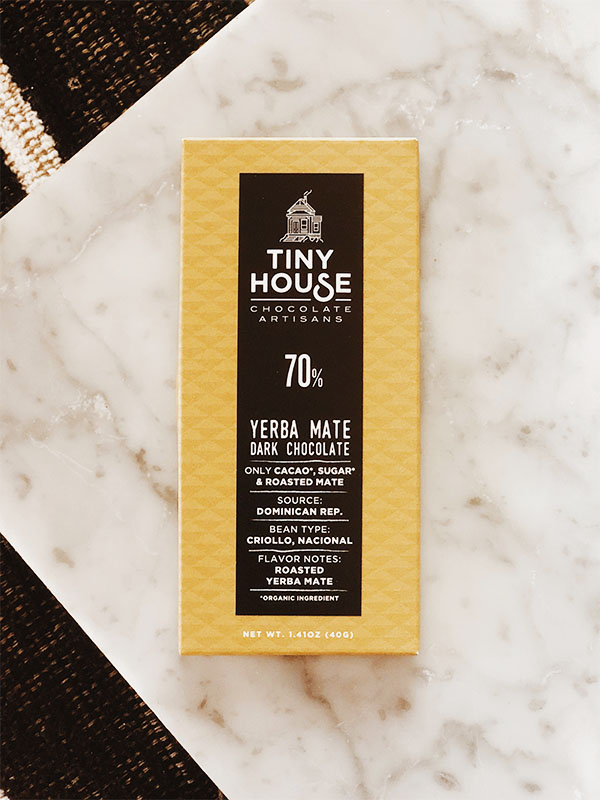
Short on Ingredients, Tall on Flavor
All Tiny House chocolate bars are vegan, gluten-free, and soy-free. They use only two or three ingredients in their dark chocolate line, with two ingredients simply cocoa beans and organic sugar, then the optional third ingredient specifically in their ”flavored line”, featuring bars like the aforementioned sarsaparilla and roasted Yerba Mate, plus Earl Grey Tea and so on…
Gustavo and Maiana always try to craft the purest chocolate possible, which means as few ingredients as necessary, “organic, non-GMO, with no soy lecithin emulsifiers,” which they think actually affects the final taste and texture.
Maiana adds –
“In our flavored line, we enjoy using ingredients that add balanced flavor to our chocolate, while also boosting health benefits, since we know the demand for superfoods continues to grow rapidly. It’s also part of our own beliefs and personal consumption habits as well.”
Tiny House features a Vegan White Chocolate collection as well, and for those they use three base ingredients: fresh cocoa butter pressed in-house, organic sugar, and coconut milk. They then add a fourth ingredient for the flavored line, such as Amazon Chai and Roasted Yerba Mate.
Tiny House Best Sellers
When I ask Maiana which bars typically sell best, she offers a unique answer –
“That’s a hard question! We understand that the palate of each human being is very unique, and we notice that in each event we participate, each retail we sell our chocolates, there’s a different best seller. And that’s wonderful! We don’t want to have just one good flavor, right?!
Then there’s also the Law of attraction – usually we sell more of the one we ‘re enjoying at the moment. Even our retailers usually sell more of the ones they enjoy most, which varies quite a bit.”
She does cave a bit, however, admitting that, if they needed to choose one flavor as king, the Tanzania 71% Dark Chocolate Bar would win out as the favorite. She describes it as “dark chocolate, with almost no bitterness… a balanced sweet taste with red fruit/berry notes, and a delicate honey/floral finish.” I’ll offer my take on this bar below in a moment.
Maiana also notes that almost everyone feels the Tanzania bar tastes sweeter than their Amazon 71% bar, despite the same proportion of organic cocoa beans and sugar in each. “I think that is something that attracts the American taste, she says, “and the flavored chocolates, Sarsaparilla Root 68% and Earl Grey 70%, are both very popular.”
Tasting the Bars
Maiana and Gustavo sent me four different bars, plus a few sample squares of 70% Brasil and 71% Amazon.
71% Tanzania Dark Chocolate
Next up, the 71% Tanzania Dark Chocolate Bar, with organic cacao sourced from the wonderful Kokoa Kamili co-op in, of course, Tanzania. For more on Kokoa Kamili and the positive impact they’re making in Africa, and in the fight for gender equality within the cacao industry, click here for our coverage back in the July ’17 issue.
This bar, with only the organic cacao and organic sugar, mentions tasting notes of berry and honey. For me, however, this bar left two unique impressions. First, so smooth, so positively delicious, I absolutely adored the 71% Tanzania Bar.
Next, although I definitely enjoyed the honey notes, I completely failed to discern other notes in the bar. I nearly ate the entire bar over the course of a day before simply giving up, surrendering… Tiny House’s 71% Tanzania Bar will go down as the one bar I’ve eaten to date for which I simply can’t decode any notes of what I’m tasting… and yet I love it!
68% Arabica Coffee Dark Chocolate
While still enjoying my morning coffee, I decided to start with the 68% Arabica Coffee Dark Chocolate Bar, featuring organic cacao sourced from the Dominican Republic.
A very, very smooth bar with the label suggesting flavor notes of espresso and red wine, I thoroughly enjoyed my tasting.
In addition to the dominant espresso flavor (and the much more subtle red wine), the bar also offered a distinct note of honey, in a very good way I might add.
Tiny House’s Arabica Coffee Bar is relatively sweet, however, so that’s not a huge surprise.
I loved this bar, just be prepared for a smooth and definitely sweet experience.
Honey, berry, whatever it may be, I expect you’ll also enjoy every single morsel of this bar.
70% Earl Grey Dark Chocolate
I then moved on to the 70% Earl Grey Dark Chocolate, with organic Dominican Republic-sourced cacao, organic sugar, and Earl Grey Tea. Although I’ve never particularly enjoyed Earl Grey tea, or bars, Tiny House’s version positively shines. Wonderful!
The tasting notes of bergamot and Earl Grey tea were, unsurprisingly, spot on, and the bar created a smooth, rich, and luscious experience to say the least. Here we are at the end of July, and at this juncture, Tiny House’s 70% Earl Grey Dark Chocolate bar sits atop my list of favorite bars for 2019! I did not see that coming!
68% Sarsaparilla Dark Chocolate
Finally, thinking I would save the best for last, I tasted the 68% Sarsaparilla Dark Chocolate (I’m a sucker for a good sarsaparilla). Also with organic Dominican Republic-sourced cacao and organic sugar, but then infused with sarsaparilla, this bar certainly lives up to its name. The flavor notes of “root beer and sarsaparilla” (of course) dominate the bar, definitely shading more to the true flavor of sarsaparilla versus what we know as root beer.
It’s a strong bar, and if you love sarsaparilla, but with much less sweetness than you may be used to if you ever drink it, you’ll likely adore this bar. If not, the strength of the sarsaparilla content may turn you off, so just expect a “strongly flavored” chocolate bar.
The Road Ahead…
As Tiny House Chocolate looks forward, a bright future sits ahead. They recently won the Academy of Chocolate 2019 Bronze Award for their Arabica Coffee 68% Dark Chocolate Bar, and were commended for the Sarsaparilla Root 68% Dark Bar as well – both inclusions made with Dominican Republic cocoa beans as we noted above. A great sign, especially considering those were their first ever entries in any chocolate competitions.
Maiana also mentioned that she and Gustavo are working on a sugar-free line of chocolate, designed for people with diabetes, focusing on a keto diet., etc. They’re nearly finished with the final tests and hope to launch the new line soon. As a perfect fit for our July ’19 issue, they’ll be sweetening this new line of chocolate with monk fruit sweetener (and erythritol).
That likely means they’ll be using Lakanto Monkfruit Sweetener, although we’ve yet to confirm as such. Click here to read all about monk fruit, as well as other alternatives to sugar in chocolate, in this issue’s Healthy Bean column.
If you’d like to connect with Gustavo and Maiana in person, they participate in several Santa Cruz local events and pop ups each and every month, so just reach out on social media if you live in the area or plan to visit.
Tiny House expects to participate in bigger events in the Bay Area soon as well, so connecting will only get easier.
Finally, Maiana notes –
“We have a lot in development right now. We’re currently revamping our brand and soon we’ll launch our e-commerce and a new website.
In the meantime, we’re also working on a project that we have inside Tiny House, to explore our resources like cocoa husks and make new products, with a zero waste mindset.
We are also planning to travel more to the sources in the near future, and to find more beans aligned to our values, like biodynamic farms, etc.”
Whatever lies ahead for Tiny House, one thing most certainly holds true – we can’t wait to taste whatever they come up with next, and once you try a bar for yourself, we’re certain you’ll feel the same.
For more on Tiny House Chocolate, CLICK HERE to visit the Tiny House Chocolate website.
Then click the links below to reach out to Maiana and Gustavo on social media as well.
+ PHOTOS BY TINY HOUSE CHOCOLATE

